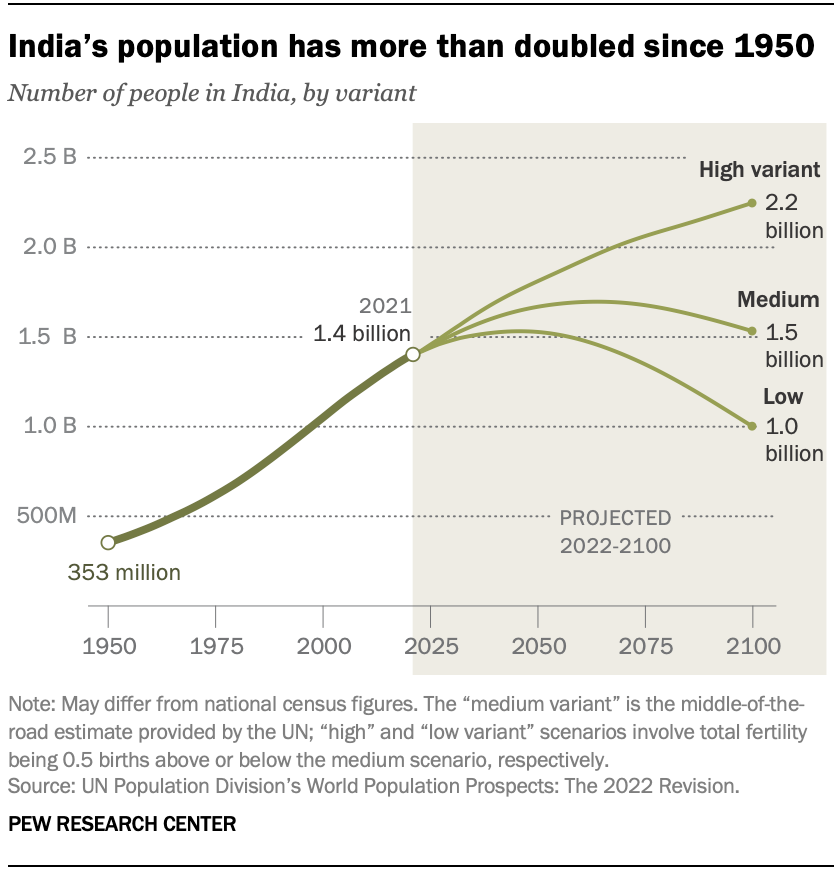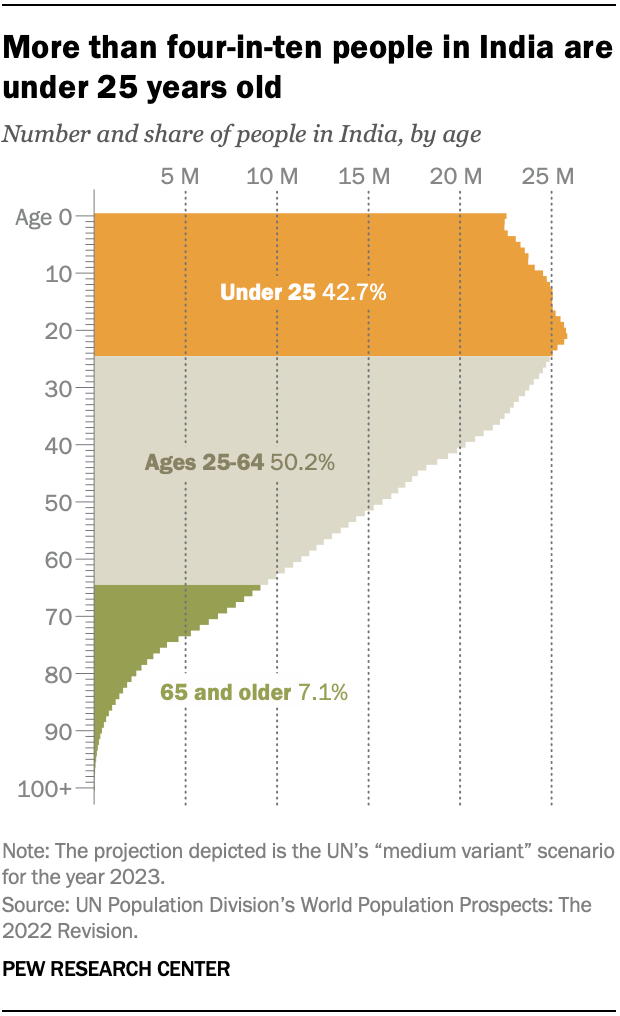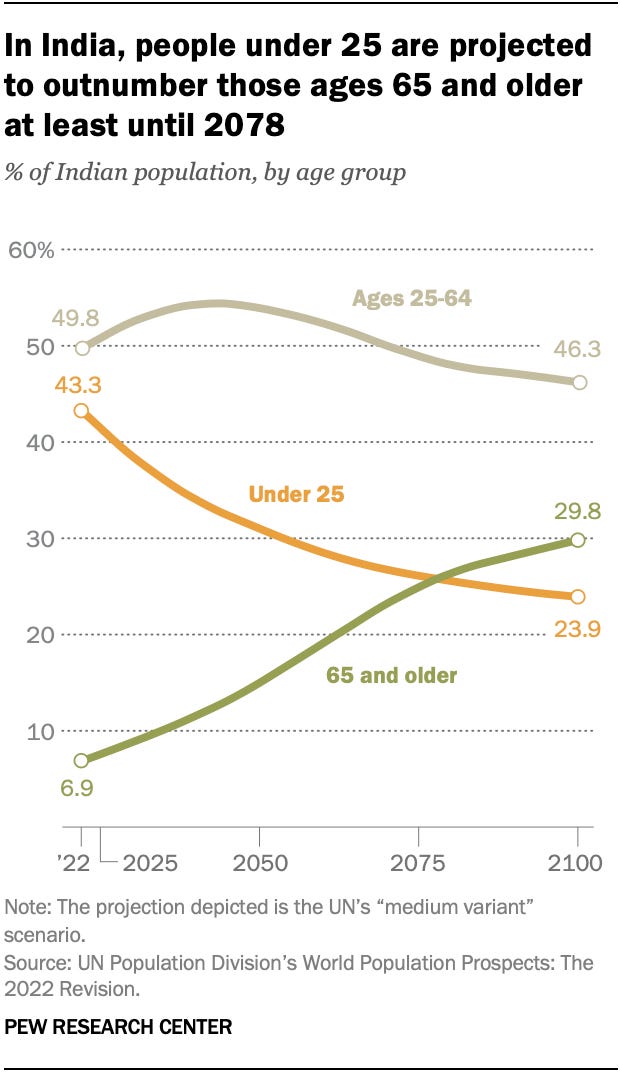Demographics and the India story
While all of you enjoy the holiday season & the last week of 2023, we deviate from our usual format of a group of stories. Instead, we focus on how demographics impacts the India growth story.
Introduction
Demographics, which refers to the statistical study of a population, can significantly influence the economic growth of a nation. Several key demographic factors play a crucial role in shaping the economic landscape. Understanding and managing these demographic factors is essential for policymakers and businesses to develop effective strategies for economic development. Nations that can harness the potential of their demographics through appropriate policies and investments are more likely to experience sustainable economic growth.
Let’s visit these parameters for India and how that is likely to shape up the India growth story.
Population Size and Growth
The overall size and growth rate of a population impact the size of the labor force and consumer base. A growing population can contribute to increased labor supply, potentially driving economic expansion, while a declining population may lead to labor shortages and reduced consumer demand.
India's population has surged by over 1 billion people since 1950, marking a significant demographic shift since the inception of UN population data. The precise figure of the country's current population is challenging to ascertain, notably due to the absence of a census since 2011.
However, estimates suggest that India now hosts a populace exceeding 1.4 billion individuals
This number now surpasses the combined populations of Europe (744 million) or the Americas (1.04 billion).
China also boasts a population exceeding 1.4 billion; however, in contrast to China's declining population, India continues to experience growth.
However, India’s population will also shrink in the longer term. According to the UN's "medium variant" projection, a moderate estimate, India's population is anticipated to surpass 1.5 billion people by the conclusion of this decade. The projection further suggests a gradual increase, foreseeing a peak at 1.7 billion people in 2064, before going down.
Age Distribution & Labour Force Participation
The age structure of a population is essential. A balanced age distribution, with a mix of young, working-age, and elderly individuals, can contribute to economic stability. An aging population may pose challenges related to workforce productivity and increasing healthcare costs.
The proportion of the population that is actively participating in the labor force is critical. High labor force participation rates can boost productivity and economic output. Factors such as education, training, and gender dynamics also influence the quality and skill level of the workforce.
A significant demographic phenomenon unfolds in India, where individuals under the age of 25 constitute over 40% of the population.
This age group is so substantial that approximately one-fifth of the global population under 25 resides in India.
Shifting our perspective on India's age distribution, the median age stands at 28, distinguishing it notably from the United States and China, where the respective median ages are 38 and 39.
Presently, only 7% of India's population comprises adults aged 65 and older, a stark contrast to China's 14% and the U.S.'s 18%, as reported by the UN.
The demographic trajectory for India is projected to maintain this distinction, with the proportion of individuals aged 65 and older expected to stay below 20% until 2063.
According to the UN's medium variant projections, it is anticipated that this demographic segment will not approach 30% until the year 2100.
Fertility Rates
Fertility rates impact population growth and, consequently, the size of the labor force. High fertility rates can lead to a youthful population, while low fertility rates may result in an aging population. While the age demographic is actually helping India’s cause, the fertility rate in India has experienced a rapid decline in recent decades, even though the current fertility rate in India surpasses that of China and the United States.
Presently, the average Indian woman is projected to have 2.0 children in her lifetime.
This rate is currently higher than that of China (1.2) and the United States (1.6).
However, it stands significantly lower than India's rates in 1992 (3.4) and 1950 (5.9).
This decline is observed across all religious groups in the country, encompassing the majority Hindu population as well as the Muslim, Christian, Sikh, Buddhist, and Jain minority groups.
Women in rural areas, on average, bear 2.1 children throughout their lifetimes, whereas their urban counterparts have 1.6 children.
Notably, both figures mark a decline from 20 years ago, when women in rural areas had an average of 3.7 children, and urban women had 2.7 children.
Sex-ratio at birth
The sex ratio at birth (SRB) is the number of male births per 100 female births in a given population. It is an important indicator of gender equality and social development, as well as a potential predictor of future economic growth.
The natural SRB is estimated to be around 105, meaning that slightly more boys are born than girls.
SRB can affect the size and composition of the labor force, which is a key determinant of productivity and output. A higher SRB implies a larger male population and a smaller female population, which may lead to labor shortages or surpluses in certain sectors or occupations. For example, a higher SRB may reduce the supply of female workers in health, education, and care services, which are essential for human capital development and social welfare. Conversely, a lower SRB may increase the demand for male workers in construction, manufacturing, and defense, which are important for infrastructure and security.
SRB can affect the savings and investment behavior of households and firms, which are crucial for capital accumulation and innovation. A higher SRB may increase the competition for marriage and resources among men, which may induce them to save more and invest in education and skills. Alternatively, a higher SRB may reduce the bargaining power and autonomy of women, which may limit their access to financial services and assets. A lower SRB may have the opposite effects, depending on the social norms and institutions that shape gender roles and expectations.
SRB can also affect the social stability and governance of a country, which are vital for economic performance and sustainability. A higher SRB may create a surplus of unmarried men, especially in rural areas where the gender imbalance is more pronounced. This may increase the risk of social problems such as crime, violence, trafficking, and radicalization. A lower SRB may create a shortage of men, especially in urban areas where the gender gap is more evident. This may increase the pressure on women to balance work and family responsibilities, as well as expose them to harassment and abuse.
In India's 2011 census, there was a significant gender imbalance with approximately 111 boys for every 100 girls.
However, recent data suggests a gradual normalization of the sex ratio at birth over the past decade. The ratio reduced to around 109 boys per 100 girls in the 2015-16 NFHS and further to 108 boys per 100 girls in 2019-21.
This trend indicates a positive shift towards a more balanced gender distribution.
Infant Mortality rates
Infant mortality rate (IMR) is the number of deaths of children under one year of age per 1,000 live births. IMR is an important indicator of the health and development of a country, as well as a factor that affects its economic growth. IMR reflects the quality of life, access to health care, nutrition, sanitation, education, and social protection of a population.
A high IMR can reduce the population growth rate and the labor force size of a country, which can lower its potential output and income.
A high IMR can increase the fertility rate of a country, as parents may have more children to compensate for the loss of their infants. This can result in a higher dependency ratio, lower female labor force participation, lower savings and investment rates, and lower human capital accumulation.
A high IMR can reduce the human capital formation of a country, as children who survive may suffer from poor health, malnutrition, cognitive impairment, and lower educational attainment.
A high IMR can impose a social and economic burden on a country, as it may increase public spending on health care, social welfare, and funeral services, while reducing tax revenue and private consumption.
Therefore, reducing IMR can have positive effects on the economic growth of a country.
Infant mortality in India has witnessed a significant 70% decline over the past three decades, marking notable progress. Despite this improvement, the current rates, with 27 deaths per 1,000 live births in 2020, are comparatively high on both regional and international scales.
In 1990, the figure stood at 89 deaths per 1,000 live births. Since 1960, the UN Interagency Group for Child Mortality Estimation has diligently compiled data, revealing a consistent annual decrease ranging from 0.1% to 0.5% in India's infant mortality rate.
While acknowledging this positive trajectory, it's essential to note that India's infant mortality rate remains higher than its neighboring countries such as Bangladesh (24 deaths per 1,000 live births), Nepal (24), Bhutan (23), and Sri Lanka (6).
Furthermore, in comparison to countries with similar population sizes, India's rate surpasses that of China (6) and the United States (5).
This context underscores the need for continued efforts and targeted interventions to further reduce infant mortality and bring India's rates in line with global standards.
Conclusion
If we try to conclude the implications based on the above demographic parameters, we should agree to the following:
Workforce contribution through a young population will be the strength of India in the coming 25-30 years. This would not only help grow the GDP but also would create the most expansive growing middle-class population, that would enable foreign investments in India which would help further the innovation 7 growth story.
A more balanced man-woman population, would help in overall equitable growth across the different population segments across the length & breadth of India.
However, the concern lies with lesser fertility rates & higher infant mortality rates. With the overall population increasing, this means that people are living more years and hence the burden of an aging population will likely hit India after 30-35 years.
Hence, the focus should be on fertility & mortality rates to allow sustainable growth even after 50 years from now. And the action needs to be taken today as the impact of the actions will only be felt after 20-25 years from now.








